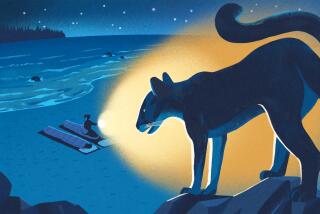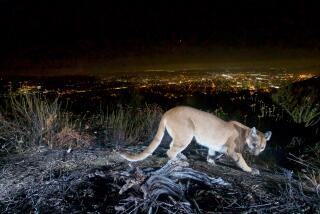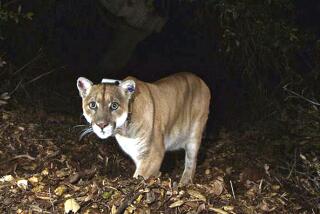Cougar’s travels take a bad turn
For eight weeks, M56 moved relentlessly, guided by a primordial compass. He covered more than 100 miles and climbed from sea level to a mile high. He traversed saw-toothed mountains, navigated busy highways and furtively skirted suburban neighborhoods.
The 20-month-old mountain lion, wearing a tracking collar affixed by UC Davis researchers, left his mother in the foothills of Orange County in early March and struck out on his own.
He traveled south through Camp Pendleton, then turned east toward the high country of eastern San Diego County, which opens on the horizon like a centerfold in a coffee table book.
M56 stunned scientists by becoming the first cougar in a decade of study to cross Interstate 15 -- most likely via an underpass where signs point to housing developments that have pushed deep into Southern California’s mountain lion habitat. Weeks later, M56 emerged from chaparral-choked wilderness and ducked under Interstate 8 about 45 miles east of San Diego.
Like any juvenile cougar, M56 was searching for food, potential mates and territory unclaimed by another male. Above all, he avoided people. He was learning to survive.
The night of April 24, he moved through a wooded area and stopped a few miles from the Mexican border, just north of Campo. After two months of moving south and east, M56 turned and headed northwest back into the woods.
Maybe it was the light of ranchettes less than a half-mile away. A stray dog might have spooked him. Or maybe he had picked up the scent of another cougar and turned to avoid a fight.
One thing is clear: M56 was about to make his first -- and last -- mistake.
The dogs shattered the silence a couple of hours before dawn. Don and Jaime Dyer awoke and thought the same thing: Coyotes must be trying to get at their sheep.
The Japatul Valley in the mountains of San Diego County is one of countless places in Southern California that is neither rural nor urban. It is country where man and nature coexist uneasily.
Dyers have lived here for 55 years, ever since Don’s father traded five acres in El Cajon for 190 acres along a creek a few miles of rugged backcountry from Campo.
Coyotes and stray domestic dogs can be a problem here. Sheep are docile animals and make easy prey if left unprotected at night.
Dyer had built a sheep pen from chain-link fencing he scavenged from the Del Mar Fairgrounds. It was 24 feet square and 5 feet tall -- secure enough to keep coyotes out.
His daughter, Addie, began raising cows and sheep to sell when she was 9. They’ve won plenty of awards at fairs. More important, the animals have earned Addie about $50,000 through the years, money the 19-year-old is using for college.
When her father reached the pen that morning, he was startled by the grisly scene. Five of Addie’s 10 sheep had been slaughtered; the partially eaten carcass of a sixth animal would be found later in the brush about 20 yards away.
“I thought it was one of my dogs,” Jaime Dyer said. The family had recently adopted an Akita, a powerful 100-pound hunting dog that wasn’t accustomed to being around livestock.
Jaime went back to bed but couldn’t sleep. “The thought of the dog doing this made me sick to my stomach.”
The next night, the Dyers locked up their dogs and secured their four remaining sheep in the pen. About 1 a.m., they were jolted awake again, this time by their stampeding cattle.
Don Dyer grabbed a .22-caliber rifle. Outside, he found his cows in a circle, facing outward and shielding their calves in the middle. They looked like a wagon train under attack.
Whatever had frightened them was gone. In the pen, Dyer found a lamb and its mother dead. This wasn’t the work of a dog.
“I’m about to be out of sheep,” he thought. “And my calves will be next.”
He stood in the dark holding his slender gun and wondered where the killer had gone. He realized how exposed he was and felt foolish.
“I grabbed the wrong gun,” he thought.
Two days before the attacks at the Dyer farm, Winston Vickers was at a county park near Campo speaking at an annual gathering of long-distance hikers about to tackle the Pacific Crest Trail, which stretches from Mexico to Canada through California, Oregon and Washington.
Vickers’ topic was his expertise: mountain lion behavior. He didn’t know it but M56, one of his subjects, was passing in the forest nearby.
“Like any young dispersing animal, he was searching for territory he could call his own and moving through landscapes he was totally unfamiliar with,” said Vickers, a veterinarian and a researcher on the UC Davis Wildlife Health Center’s lion tracking project. “What we’re looking at is: What decisions do they make time after time?”
The study began in 2001 to assess the impact of lions on endangered Peninsular bighorn sheep in the desert mountains of Riverside, San Diego and Imperial counties. Over the years, the study’s scope has expanded, and the movements of collared cougars have shed light on health and disease issues, genetic patterns and the behavior of cats in the so-called wildland-urban interface.
One statistic stands out: Of 53 mountain lions that have been trapped, tranquilized and collared, 19 have been killed by vehicles or shot, far more than have died from natural causes.
“The closer lions are to people, the more likely they’re going to die,” Vickers said. “Any interaction with humans, broadly speaking, will likely end up badly for the lion.”
Mountain lions are fast and powerful; they can leap 18 feet into a tree and take down a bull elk six times their weight. They’re also solitary and elusive. Attacks on humans are extremely rare, despite the fact that more than half the state is considered cougar territory.
“Lions are among us constantly, and for the most part they stay out of trouble,” said Marc Kenyon, who oversees mountain lion studies for the state Department of Fish and Game. “When people report to us they’ve seen a mountain lion and ask what they should do, I tell them they should consider themselves extremely lucky because seeing one is very rare.”
Mountain lion attacks on pets and livestock are more common, although the extent is difficult to determine. One measure is the number of lions legally killed under depredation permits issued by state wildlife managers. In the year ending Sept. 30, 2009, 103 lions were killed by permit. Relocation is considered too risky.
Mountain lions have been killed for preying on livestock in California since the Spanish friars brought cattle to the missions. In 1907, the state Legislature approved a bounty for cougars.
Jay Bruce, a tracker and guide at Yosemite National Park, was the state’s first official lion hunter. Starting pay was $100 a month and $20 for each animal killed. Bruce killed 668 lions over 31 years. Newspaper accounts and a 1933 documentary turned him into a folk hero.
“If I had a million dollars, I would still hunt lions,” he told a reporter. “The long chase over the snow, racing after the dogs through underbrush, swimming rivers, jumping chasms, alone in the wilderness -- that’s life.”
The state abolished the bounty in 1963, and in 1990 voters approved Proposition 117, which outlawed sport hunting of mountain lions and designated them a “specially protected species.”
But they’re far from endangered. It’s estimated there are about 5,000 mountain lions in California, double the population in the 1970s.
Yet given that an adult cougar’s territory can range more than 100 miles, the continued fragmentation of their habitat concerns researchers, who say it’s inevitable that human conflicts with mountain lions will increase.
Particularly with young male lions such as M56.
“He was like a youngster who leaves home and is trying to make a living,” said Linda Sweanor, a wildlife scientist who has studied mountain lion behavior in the West for 25 years. “They’re still learning the ropes. Sometimes they take risks that an adult cougar would not.”
Don Dyer’s students raise sheep, pigs and chickens from conception to slaughter. They grow hay and learn to handle a rope. In a machine shop next to the rodeo grounds in Lakeside, they learn welding, plumbing and electricity.
“Anything you need to keep a farm running,” Dyer said. “Finals is always barbecued chicken.”
Dyer teaches agriculture as his late father did. But in a sense he’s teaching history. El Capitan High School may be home of the Vaqueros, but this former ranching community, a good drive from Dyer’s home, is now a far-flung suburb of San Diego. Only a handful of his 440 students will pursue agricultural careers.
“Most of the kids are three or four generations removed from farming. They’ve been raised to know animals from Disney -- they’re all cute little calves and kitties,” Dyer said. “My job is to teach them how agriculture really works.”
Among the realities is that farm animals are production units, and natural predators are a cost of doing business.
Dyer, 48, has lived most of his life in the Japatul Valley. He had never seen a cougar in the wild. Although he knows that the entire region, rich with deer, is prime lion habitat, they had never posed a problem.
“Fate brought him to us,” he said.
Vickers, the UC Davis researcher, didn’t know of M56’s travels until the animal’s collar was returned to him. He says it was opportunity, not predetermination, that led M56 to Dyer’s sheep. He faults the Dyers for not enclosing the pen with a secured top, even if they had never had a problem with cougars before.
“It’s surprising and sad that they’ve been out there that long and didn’t know what the threat was,” Vickers said.
But Dyer says a mountain lion attack could just as well have happened during the day, when his sheep and cattle are scattered and grazing. He believes M56 was an outlier: the rare lion bold or hungry enough to risk going after livestock. “You can’t build a pen with a roof on it over 200 acres,” he said. “Guys who run herds of sheep, they employ sheepherders who watch over them all the time. I’m not a sheepherder. I’m a schoolteacher.”
Later, he would teach his students how the law works in such cases. He contacted federal agriculture officials. A depredation permit was secured from state Fish and Game officials. A federal trapper drove out to the Dyer place and baited a trap.
The next morning, M56 was in the cage. He was graceful and muscular with a flowing, regal tail and piercing yellow-green eyes. Jaime Dyer was surprised by how calm he was.
The trapper returned with a gun. Jaime left him to do his job.
“I did not care to watch,” she said later. “Was I happy he was dead? No. Why would I be happy he was dead? He was a beautiful animal.”
More to Read
Sign up for Essential California
The most important California stories and recommendations in your inbox every morning.
You may occasionally receive promotional content from the Los Angeles Times.









